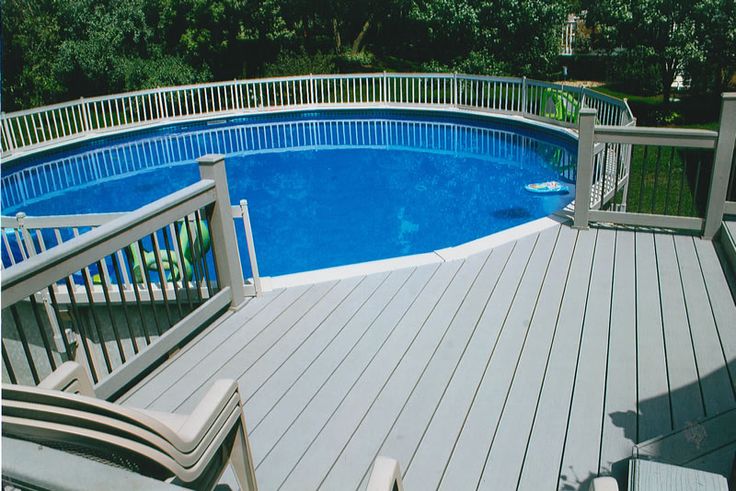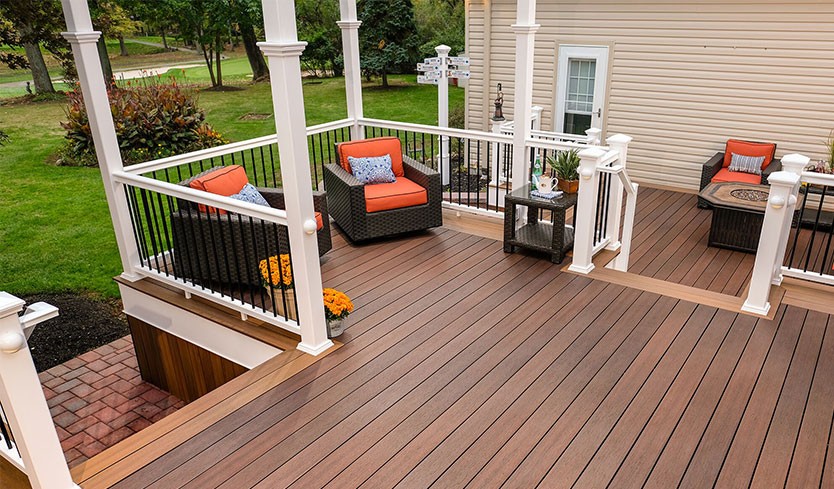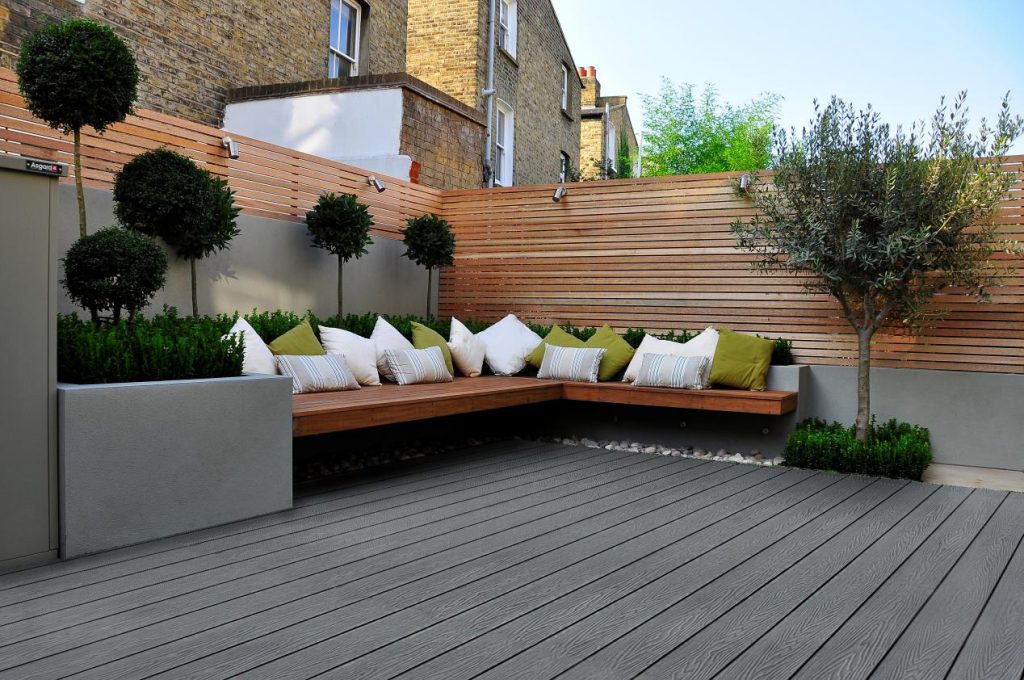Above ground pools have long been a popular choice for homeowners who want to enjoy the summer without committing to the high cost and permanence of an inground pool. But to truly elevate the look, safety, and functionality of an above ground pool, the decking around it plays a crucial role. That’s where composite decking for above ground pools comes in—a modern solution that combines beauty, performance, and ease of maintenance.
Ecoscape UK and Similar Brands
Table of Contents
Introduction
In this guide, we’ll explore everything you need to know about composite decking for above ground pools, including its benefits, design ideas, installation tips, material comparison, and maintenance advice. Whether you’re building a brand-new backyard oasis or upgrading an existing setup, this blog post is your go-to resource.
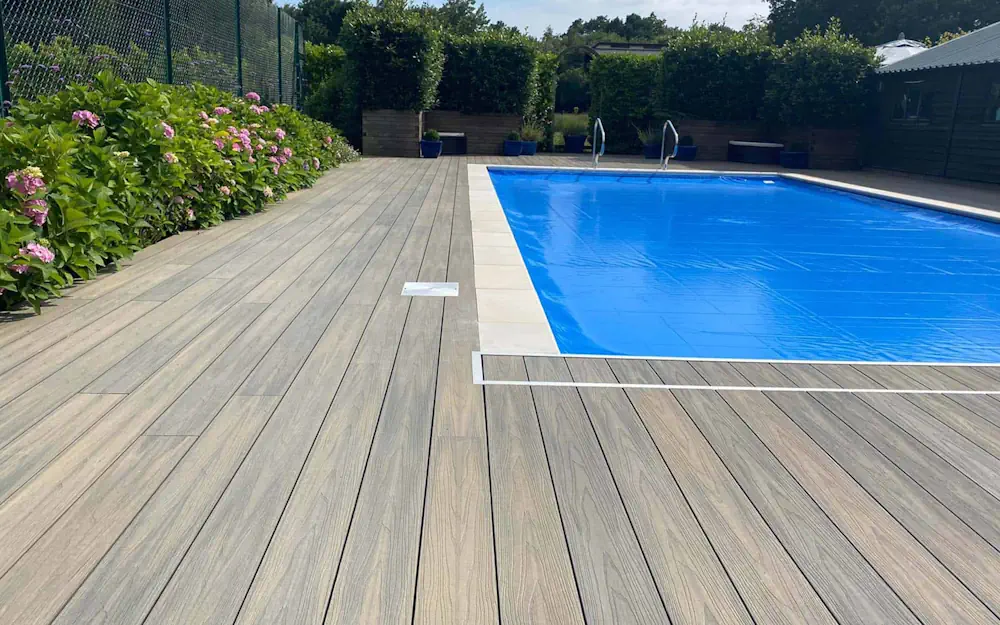
Why Choose Composite Decking for Above Ground Pools?
When it comes to pool decking, you have several choices—wood, PVC, aluminum, stone, and composite. Among these, composite decking has surged in popularity for its perfect blend of durability and aesthetics. Here’s why composite decking for above ground pools is a smart investment:
1. Water Resistance
One of the biggest challenges with pool decks is constant exposure to water. Traditional wood tends to warp, crack, or rot when wet. Composite decking, made from a mix of wood fibers and recycled plastic, is highly resistant to moisture. This prevents swelling, splintering, and decay—common issues in wood decks.
2. Low Maintenance
Unlike timber, composite boards don’t require sanding, staining, or sealing. Occasional soap-and-water cleaning is all that’s needed to maintain their appearance. For pool owners, this means more time swimming and less time maintaining.
3. Slip Resistance and Safety
Composite decking products often include textured surfaces or grooves to improve traction, even when wet. This reduces the risk of slipping—a critical consideration for pool environments where bare feet and splashes are the norm.
4. Aesthetic Appeal
With various colors, textures, and finishes, composite decking can mimic the look of natural wood or create a sleek modern vibe. Whether your design theme is coastal, rustic, or contemporary, composite boards provide design flexibility that suits any style.
5. Eco-Friendly Material
Many brands manufacture composite boards using recycled plastics and reclaimed wood fibers. Choosing composite decking supports sustainable building practices while providing a product that lasts for decades.
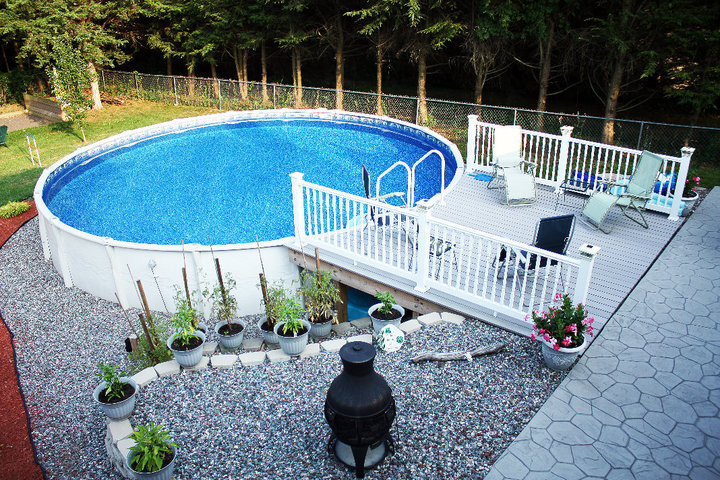
Design Ideas for Composite Decking Around Above Ground Pools
Whether you’re planning a full wrap-around deck or a small lounging area, composite decking can be tailored to any vision. Here are some inspiring design ideas to help you get started:
1. Wrap-Around Deck with Built-in Steps
A full perimeter deck adds visual balance to your above ground pool and offers plenty of space for seating, tanning, or hosting guests. Built-in steps with contrasting colors or textures add both functionality and style.
2. Multi-Level Decking
Composite decking lends itself well to tiered designs. You can create multiple levels for different activities—one for swimming access, another for dining, and a third as a sunbathing platform. Railings and lighting between levels add safety and ambiance.
3. Deck with Integrated Seating and Planters
Built-in benches made from the same composite material can seamlessly blend into the deck, offering comfort without the need for extra furniture. Add planters to soften the look and bring in greenery.
4. Partial Deck with Pergola
If you don’t want to surround the entire pool, a partial deck works perfectly for smaller yards. Add a pergola to one corner for shade and a relaxing escape from the sun. Composite decking makes it easy to install pergola footings without damage or rot.
5. Poolside Lounge Zone with Privacy Screens
Use composite slat panels or cladding to add privacy screens to one side of your deck. It provides a spa-like feel, especially when combined with cozy furniture and soft lighting.
Comparing Composite Decking to Other Pool Deck Materials
Before committing, it’s helpful to compare composite decking for above ground pools to other commonly used materials:
| Feature | Composite Decking | Pressure-Treated Wood | PVC Decking | Aluminum Decking |
|---|---|---|---|---|
| Water Resistance | Excellent | Poor | Excellent | Excellent |
| Maintenance | Low | High | Low | Low |
| Durability | High (20–30 years) | Moderate (10–15 years) | High (25+ years) | Very High |
| Slip Resistance | Good (textured surface) | Varies | Good | Can be slippery |
| Aesthetic Options | Many (wood-look, colors) | Limited | Limited | Industrial Look |
| Heat Retention | Medium | Low | High | High |
| Environmental Impact | Recycled materials | Natural but often treated | Not eco-friendly | Recyclable |
| Cost (per sq ft) | $8–$15 | $4–$8 | $9–$16 | $10–$18 |
As the table shows, composite decking strikes a balance between aesthetics, performance, and cost—making it an excellent choice for pool owners.

Installation Tips for Composite Decking Around Pools
If you’re considering installing composite decking yourself, here are some best practices to ensure a safe and professional-looking result:
1. Plan for Drainage
Proper drainage is essential to prevent pooling water under or around the deck. Ensure there’s a slight slope or spacing between deck boards to allow water to escape.
2. Use Appropriate Fasteners
Many composite deck boards require specific fasteners or hidden clip systems. These systems help maintain spacing, prevent surface damage, and provide a clean look.
3. Add Reinforced Framing
Above ground pools are round or oval in shape, but decking boards are straight. You’ll need to frame around the pool carefully, possibly using flexible edging or custom framing to match curves.
4. Leave Expansion Gaps
Composite materials expand and contract with temperature changes. Leave appropriate gaps between boards and along walls to avoid buckling or warping.
5. Install Safety Features
Add railings or fences if your deck is high off the ground, and consider built-in lighting or glow strips on steps for nighttime use. Safety is essential when children are involved.

Maintenance and Longevity of Composite Decking
One of the standout advantages of composite decking for above ground pools is its minimal maintenance. However, some simple care practices will ensure your deck looks its best for years to come.
1. Regular Cleaning
Use a soft-bristle brush and soapy water to remove dirt, algae, or sunscreen residue. Avoid using bleach, which can degrade the surface.
2. Avoid Abrasive Tools
Don’t use metal shovels or stiff wire brushes on composite boards, as they can scratch the surface. In winter, use plastic shovels to clear snow if needed.
3. Protect from Heavy Items
While composite decking is durable, extremely heavy furniture or grills should have protective pads underneath to prevent denting or scratching.
4. Inspect and Tighten Fasteners
Periodically check fasteners and framing to ensure everything remains secure, especially in high-traffic pool areas.
With proper care, most composite decking products will last between 25 to 30 years, even in wet, sun-exposed environments.
Composite Decking for Above Ground Pools: Cost Breakdown
Here’s a quick look at the cost considerations when using composite decking for your above ground pool:
| Component | Estimated Cost (USD) |
|---|---|
| Composite Deck Boards | $8–$15 per sq. ft. |
| Joists and Substructure | $4–$7 per sq. ft. |
| Fasteners and Accessories | $1–$2 per sq. ft. |
| Labor (if hiring a pro) | $10–$18 per sq. ft. |
| Total Estimated Cost | $20–$42 per sq. ft. |
DIY installation can save 30–50% of the total cost, but always factor in time, tools, and safety considerations.
Environmental Benefits of Composite Decking
As sustainability becomes a greater priority, composite decking offers an environmentally responsible option:
Recycled Content: Most boards are made from reclaimed wood waste and recycled plastic bottles or bags.
Longer Lifespan: Composite decking lasts longer than wood, reducing waste over time.
No Harmful Chemicals: No need for chemical sealants or stains that can leach into the soil or water.
Low Maintenance: Less water, soap, and energy required over the years compared to pressure-washing or sealing wood decks.
By choosing composite decking for your above ground pool, you’re not only investing in your home—you’re also making a greener choice.
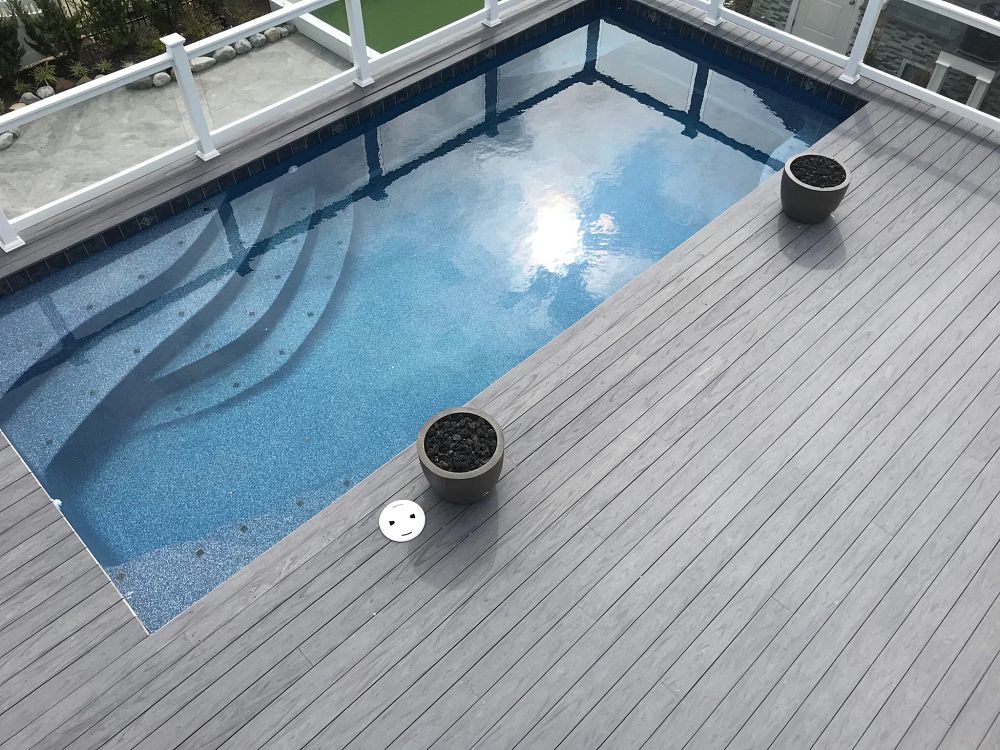
Final Thoughts
From functionality and safety to aesthetics and longevity, composite decking for above ground pools is one of the best decisions homeowners can make when creating a stunning poolside retreat. Its water-resistant properties, low maintenance needs, and stylish finishes make it an ideal companion to any pool, whether you’re building a modest backyard escape or a show-stopping entertainment hub.
While the upfront investment is higher than wood, the long-term savings and peace of mind are well worth it. Choose a quality composite brand – Hosung WPC, follow best practices during installation, and enjoy summers filled with fun—not maintenance.
FAQs: Composite Decking for Above Ground Pools
1. Is composite decking hotter than wood?
Yes, composite materials tend to retain more heat than wood, especially darker colors. However, choosing lighter shades and products with heat-dissipating technologies can greatly reduce surface temperature, making them more comfortable for bare feet on hot summer days.
2. Can you install composite decking directly on the ground around a pool?
No. Composite decking must be installed on a properly ventilated substructure or joist system. Direct installation on the ground traps moisture, which can lead to mold or mildew on the underside of the boards and reduce the lifespan of the deck.
3. Does chlorine affect composite decking?
High-quality composite decking is engineered to resist damage from pool chemicals like chlorine. However, it’s a good practice to rinse off chlorine splashes with fresh water occasionally to preserve color and surface integrity over time.
4. How long does composite decking last around a pool?
Most premium composite decking comes with a 25–30 year warranty. With correct installation, regular cleaning, and avoidance of heavy surface damage, composite decking can last even longer—making it a highly durable poolside solution.
5. Can I use composite decking with a saltwater pool?
Yes, many composite decking products are designed to withstand exposure to saltwater as well. Just like with chlorine, rinsing occasionally and choosing a corrosion-resistant substructure will ensure long-term performance near saltwater pools.
6. Is composite decking slippery when wet?
While any surface can become slippery, most composite decking boards are designed with slip-resistant textures or grooves. Brands specifically market pool-friendly surfaces that meet traction standards, making them safer than many tile or polished concrete alternatives.
7. Can I paint or stain composite decking?
Generally, no. Composite decking is manufactured with color pigments and protective caps that do not absorb paint or stain well. If you want a different color, it’s best to choose a different shade at purchase rather than trying to repaint later.
8. Does composite decking fade over time?
Uncapped composite boards may fade slightly due to UV exposure, but most modern capped composite decking is engineered to resist fading and staining. Warranties often cover color fading for 20+ years, especially when properly maintained.
9. Can composite decking be cut and shaped like wood?
Yes, composite decking can be cut, drilled, and shaped using standard woodworking tools. However, it’s denser than wood, so sharp blades and proper ventilation are recommended during cutting, especially for curved or custom deck designs.

